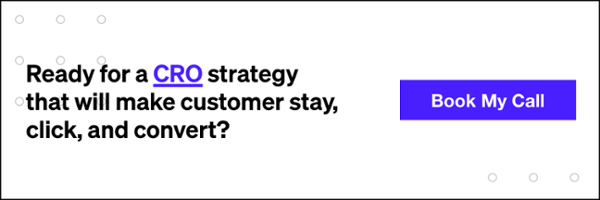Website CRO: Optimize Landing Pages With These Tips

Imagine the following situation:
You are a business owner with a moderately successful e-commerce website that sells running shoes. You have a pretty recognizable brand and as a result, receive a fair amount of traffic to your site each month. This all sounds fine and dandy right? Right! But, despite all this traffic, your conversion rates are uncommonly low considering your high-quality product, great prices, and popular brand name. Why?
If I had to guess, I’d say that you haven’t taken the time to implement a tried-and-true conversion rate optimization (or CRO in laymen’s terms) strategy. Sure, you’ve done your due diligence and created highly targeted Facebook audiences to ensure that you’re only driving the most qualified traffic to your site and you’ve optimized your entire website for all the necessary keywords.
But, the fact of the matter is that you only have a few seconds (if that) to make a positive impression on your visitors. If your landing page doesn’t make the cut, bounce rate (the percentage of visits that interact with page vs those who leave immediately) will be high, and your conversion rates are going to be low. Simple as that.
So, why do some landing pages convert and others don’t? Well, it depends. It varies by person, product, and situation. Some people may react more positively to reading content before seeing the call to action to take the next step in the conversion funnel, while others may want to be told what to do right away and may not even bother reading the copy at all. And CTAs and content aren’t the only thing that people react differently to – icons, images, colors, button sizes, & more all play a major role in the website conversion rate
Pretty overwhelming right? With so many different page elements, it is difficult (if not impossible) to fit every customer’s aesthetic and underlying psychological needs. Which is why testing is a crucial CRO strategy element in order to increase user experience. Since you can’t perfectly appeal to everyone, might as well appeal to the large majority right?
Therefore, the fact remains: if you’re interested in improving your conversion rates, you better understand that importance of testing. Let’s look at a few on-page elements that you can A/B test against each other to analyze and (if done properly) increase your conversion rates!
Icons & Images
With all of the resources available to designers and web developers these days, the sky is the limit when creating an aesthetically pleasing landing page. We have high resolution images, cutesy icons, and compelling videos at our fingertips. Our job is to create a positive experience for our customers when they visit the site. And factors such as images, icons, and overall aesthetics have a key role in shaping that experience.
These page elements are also a great place to start A/B testing. For a quick and relatively effortless test, try testing one image or icon against another. Let’s refer back to the scenario above. Perhaps your current landing page has a picture of a person running on the pavement in your flashiest new running shoes. A/B this picture against someone running on the grass in your flashies new running shoes instead. It’s a small change but you’d be surprised how drastic a difference these small changes can make.
Calls-To-Action (CTA)
The CTA is the bossiest of all page elements. CTAs are short commands, usually in button or hyperlink form, that tells the user to take some sort of action. Whether that be “Read More Articles” on a lead gen site or “Shop Now” on an e-commerce site, the CTA is a necessary element on all landing pages. Without a clear CTA, the user may be confused as to what the next step in the funnel is. Imagine going through the checkout process and not being prompted with “Provide Shipping Information” and “Checkout Now” buttons. Chances are, most of us would know what to do, but it would be weird right?
Believe it or not, there is a lot more to a CTA button that just meets the eye. It may look like a standard blue button that says “Shop Now”, but behind that, there are a multitude of different elements to test. What if the button was yellow instead of blue? Or said “Start Shopping” instead of “Shop Now”? And we haven’t even gotten into the shape and size of the button! Consider testing one of these variables during your A/B test.
A CTA can also take the form of a headline. While you should definitely have a button or hyperlink telling the user what next steps to take as well, the headline is most likely the first person a user sees when visiting your landing page. Come up with a few headlines and pick your two favorites. A/B test them against each other and see which made the best first impression on visitors.
Content & Copy
The different variations that your web copy can take is endless. And while we won’t get too granular discussing sentence structure or use of one adjective over another, other more general content elements can be the difference between getting or losing a conversion.
Is the current copy on your landing page short and sweet? A/B test it against longer copy and see which performs better. Or if your current copy is longer and in paragraph form, consider A/B testing it against the same content expressed using a combination of bullet points and short paragraphs. You can also consider A/B testing different copy all together! If the current copy in your website is written in first person, write another paragraph written in second person perspective, test it against the first, and see which paragraph your audience responds to best!
Page Arrangement (Order)
Should the copy go above the CTA or below it? Should there be multiple CTAs throughout or just one prominent one? The limit to questions about page order does not exist. But to begin, I suggest sticking to the basics and testing whether the content should go above or below the CTA on your landing page. This simple test is far-reaching and effective and can lay the groundwork for the rest of your website conversion rate testing strategy.
Color Combinations
Obviously, we all love to use our brand or company’s colors in everything we do. After all, our brand is our baby and we want to show it off to the world. But, using your brand’s colors may not be the wisest choice when it comes to increasing your conversion rates. Or is it? The only way to find out is the test it.
Test button color, form color, text color, page color – you name it, you can test it! Different colors mean different things to different people. For example, many people connote green with positive action and affirmation while red is associated with passion, excitement, and urgency. See which color best resonates with your users by A/B testing it. And if it just so happens to work with your brand’s colors, the better!
Testimonials
Let’s be honest – the primary purpose of a landing page is to urge users to move downward in conversion funnel & convert. But it’s important to remember that we’re still people talking to other people albeit through a computer. This is why providing testimonials, or social proof, are such an effective marketing tactic. People are inherently more likely to purchase a product or service that others are already purchasing. As a result, including testimonials on your landing page is a great way to increase conversions by showing customers how popular a certain product is.
So, where does A/B testing come into all this? Just like other landing page elements, one testimonial can be tested against another. Some people may respond best to a testimonial that praises the product or service directly while others may like seeing the benefits those features provide. Test one testimonial against another and see what resonates with your customers.
Wrapping Up
These are just a few of the many page elements that you can A/B test against each other to optimize a landing page for a higher conversion rate. Remember to develop a comprehensive website conversion rate strategy before you dive head first into A/B testing for optimal results. Now stop twiddling your thumbs and get testin’! For some awesome tools to help you get started with A/B testing click here.
Our Editorial Standards
Reviewed for Accuracy
Every piece is fact-checked for precision.
Up-to-Date Research
We reflect the latest trends and insights.
Credible References
Backed by trusted industry sources.
Actionable & Insight-Driven
Strategic takeaways for real results.







